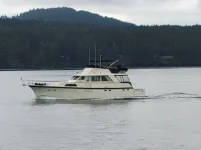dar636
Well-known member
- Joined
- Feb 19, 2016
- Messages
- 276
- Status
- OWNER - I own a Hatteras Yacht
- Hatteras Model
- 58' YACHT FISHERMAN (1970 - 1981)
Hello,
Well the rains are back in force in the great NW, the YF has developed a leak I assume from the flybridge hold down screws into coring, and its coming out of the port side pilothouse door extrior light. Real ugly brown/red stains.
Is the fix to rebed all of the screws? Is there a better way? How is it done?
Well the rains are back in force in the great NW, the YF has developed a leak I assume from the flybridge hold down screws into coring, and its coming out of the port side pilothouse door extrior light. Real ugly brown/red stains.
Is the fix to rebed all of the screws? Is there a better way? How is it done?


